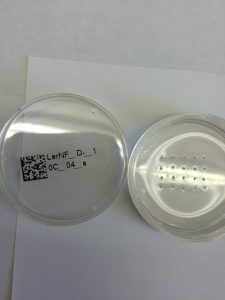When discussing the development of any type of organism, the topics of both genetics and the environment are strongly considered, which has contributed to the debate known as “nature vs. nurture.” At the Donohue Lab, both heredity and the environment are studied as contributors to the germination patterns of Arabidopsis thaliana seeds, but the two factors aren’t as black and white as some “nature vs. nurture” lectures may make them seem. While a human development class may ask the question “Is the parents’ genetics or the environment of the offspring a higher indicator of gene expression?” the Donohue Lab is currently addressing the question “Is the maternal environment or offspring environment a higher indicator of gene expression and germination patterns?” In this research, genetics and the environment are considered together while their interconnection is being further explored.
It was originally expected that the seed’s environment would be a stronger predictor of its germination patterns that the maternal environment. After all, it’s nearly impossible for the mother plant to know what conditions the seed will face when it germinates due to the varying length of dormancy. What if the maternal plant lived in a dense canopy, but a fire comes and wipes out most of the seed’s possible competition? Unexpectedly (as researched by lab members Lindsay Leverett and Gaby Auge in a paper that’s currently in press), the maternal environment seemed to have a much more significant impact on the proportion of seeds that germinated. Furthermore, when the maternal plants lived (while the seeds were maturing pre-dispersal) under a simulated canopy, meaning greater competition when the seeds dispersed and germinated, the seeds were more likely to germinate. Which is really strange time to germinate, as you’d might expect that the seed will be less likely to survive when there were more plants around competing for the same resources.
The maternal environments used in the previous study were simulated with filters. A clear filter allowed white light to pass through, mimicking little to no competition. A green filter both lowered the irradiance of light that passed through and altered the red to far red light ratio, mimicking a dense canopy. My project introduces a neutral filter, which lowers the irradiance of light but does not change the light ratio, which could help explain the results of the previous experiment. This will answer the first question of the project: is light acting as a source of information (light ratio) or a source of energy (level of irradiance)?
The second objective is to determine what role FLC (FLOWERING LOCUS C) plays in the germination patterns. Four genotypes will be used: Ler (nonfunctional FLC), LFC (high FLC expression), 145, and 146 (both of which have high FLC expression that has been knocked down through RNA interference).
Therefore, this project has a lot of different variables that will be analyzed to determine their impact on germination. We’ve already prepared 2304 plates of agar (!) and put 20 seeds in each according to genotype, maternal light treatment, germinant light treatment, and temperatures. We’ve also seeded them, so the plates now look like this:

We’ve also done the first week germination census, so some data has started to come in! After another week, there will hopefully be enough data to begin analyzing the results. All in all, the goal of this project is to explore the variety of information sources that can have an impact on germination and how genetics and the environment play a role together.
